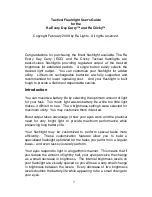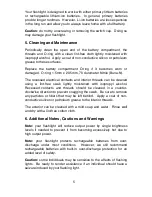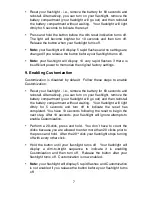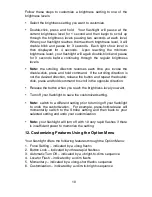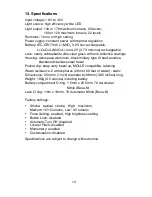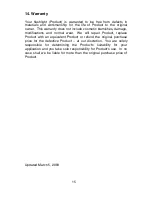
5
Your flashlight is designed to work with either primary lithium batteries
or rechargeable lithium-ion batteries. In general, primary batteries
provide longer runtimes. However, Li-ion batteries are less expensive
in the long run and allow you to always leave home with a full battery.
Caution:
do not try unscrewing or removing the switch cap. Doing so
may damage your flashlight.
5. Cleaning and Maintenance
Periodically clean the open end of the battery compartment, the
threads and O-ring with a clean lint-free cloth lightly moistened with
isopropyl alcohol. Apply a coat of non-conductive silicon or petroleum
grease to these surfaces.
Replace the battery compartment O-ring if it becomes worn or
damaged. O-ring: 1.5mm x 20.5mm, 70 durometer Nitrile (Buna-N).
The recessed electrical contacts and interior threads can be cleaned
using a lint-free swab lightly moistened with isopropyl alcohol.
Recessed contacts and threads should be cleaned in a counter-
clockwise direction to prevent snagging the swab. Be sure to remove
any particles or fibers that may be left behind. Apply a coat of non-
conductive silicon or petroleum grease to the interior threads.
The exterior can be cleaned with a mild soap and water. Rinse well
and dry with a lint-free cotton cloth.
6. Additional Notes, Cautions and Warnings
Note:
your flashlight will reduce output power by single brightness
levels if needed to prevent it from becoming excessively hot due to
high output power.
Note:
your flashlight protects rechargeable batteries from over-
discharge under most conditions. However, we still recommend
rechargeable batteries with built-in over-discharge protection for an
added level of safety.
Caution:
some individuals may be sensitive to the affects of flashing
lights. Be ready to render assistance if an individual should have a
seizure induced by your flashing light.


